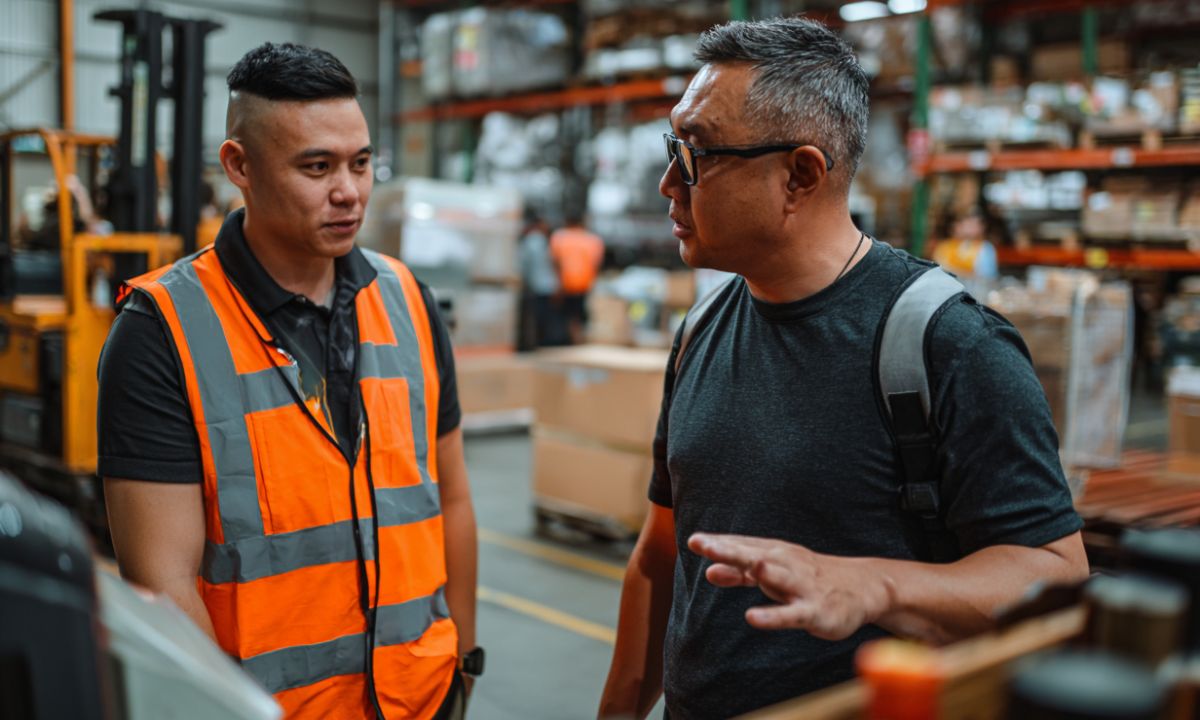Language Barriers and Safety Communication: Protecting Queensland's Culturally Diverse Workforce

Imagine a construction site supervisor shouts an urgent warning about falling debris, but several workers don't understand English well enough to comprehend what's happening. In those critical seconds, the language barrier becomes a serious safety risk.
This scenario plays out across Queensland workplaces every day, often not as dramatically, but with equally important safety implications. With over 22% of Queensland's population born overseas and more than 10% speaking a language other than English at home, multilingual workforces are the norm rather than the exception.
For employers, safety trainers, and HR professionals, addressing language barriers is not only about inclusion, but it also helps prevent injuries and builds a workplace where everyone can understand and follow critical safety protocols.
The Real Risks: When Language Barriers Compromise Safety
Limited English proficiency significantly increases workplace safety risks. Workers from culturally and linguistically diverse (CALD) backgrounds are being seriously injured in workplace incidents.
The dangers manifest in various ways:
- Misunderstood emergency procedures: Workers may not fully grasp evacuation routes or emergency responses.
- Confusion about hazardous materials: Chemical labels and warning signs might be misinterpreted.
- Improper use of protective equipment: Instructions for correct PPE usage can be lost in translation.
- Psychological barriers: CALD workers often hesitate to report hazards or ask questions due to language or cultural differences.
Queensland's Policy Framework: What's Required
Queensland has recognised these challenges through various government policies that set expectations for inclusive workplaces. The Queensland Multicultural Action Plan outlines key requirements for employers, including:
- Providing access to interpreters and translated materials
- Training staff in cross-cultural communication
- Ensuring safety information is accessible regardless of language background
Government agencies themselves are setting examples through Equity and Diversity Plans with targets for employing people who speak languages other than English. The public sector has set a target of 12% for staff who speak languages other than English at home, demonstrating the commitment to linguistic diversity in the workforce.
Building an Inclusive Safety Communication System
Creating effective safety communication across language barriers requires an in-depth approach. Here are proven strategies that Queensland organisations are implementing:
Visual and Multilingual Safety Systems
The most successful multilingual workplaces use a combination of visual cues and translated text to overcome language barriers:
- Universal symbols and colour-coding: International safety symbols are instantly recognisable regardless of language background.
- Strategic placement: Signs positioned at eye level in high-traffic and high-risk areas ensure visibility.
- Multiple languages: Including translations of the most common languages spoken in your workplace, alongside English.
- Regular reviews: Safety signage should be checked regularly for accuracy and relevance.
Multilingual Training and Awareness
Safety training must be accessible to everyone, regardless of their English proficiency:
- Translated materials: Developing induction guides, manuals, and toolbox talks in multiple languages
- Bilingual trainers: Using trainers who speak workers' native languages or providing interpreters during critical training
- Demonstration-focused learning: Incorporating hands-on demonstrations that transcend language barriers
- Video resources: Creating visual training resources with subtitles in multiple languages
Cultural Safety Ambassadors
One of the most effective approaches involves appointing cultural safety ambassadors from within the workforce:
- These trusted team members bridge communication gaps between management and CALD workers.
- They receive training in leadership, workplace rights, and cross-cultural communication.
- They help identify potential safety risks arising from language misunderstandings.
- They provide a comfortable channel for CALD workers to ask questions or report concerns.
Technology Solutions
Digital tools are increasingly helping organisations overcome language barriers:
- Translation apps: Real-time translation tools allow for immediate communication in emergency situations
- QR codes: Linking to multilingual instructions or safety videos via scannable codes on equipment
- Group messaging platforms: Using apps with translation features for urgent safety alerts
- Virtual reality training: Customizable VR safety modules that can be set to different languages
Also read: The Invisible Injury: Why Mental Health Is Now the Biggest Safety Risk in Australian Workplaces
Queensland Organisations Leading the Way
Several Queensland-based organisations have implemented successful multilingual safety initiatives worth highlighting:
Construction: Pictogram-Based Safety Communication
A major Brisbane construction firm introduced comprehensive pictogram-based safety signage alongside multilingual induction sessions. The company worked with cultural consultants to ensure the visual elements were universally understood and culturally appropriate.
Results included:
- 28% reduction in reportable incidents within the first year
- Significantly improved hazard reporting from CALD workers
- Positive feedback from workers during anonymous safety surveys
The project manager stated, ‘The initial investment in multilingual materials seemed expensive, but it paid for itself many times over in prevented injuries and improved efficiency.’
Healthcare: Bilingual Staff and Digital Translation
A Queensland health service network implemented a bilingual health workforce initiative that employed staff who could bridge language gaps. They supplemented this with digital translation tools for healthcare safety protocols.
The approach included:
- Appointing bilingual safety advisors in key departments
- Creating digital libraries of translated safety procedures accessible via QR codes
- Developing a ‘language buddy’ system for new CALD employees during their orientation period
The program evaluation showed improved staff satisfaction, better understanding of safety procedures, and fewer medication and treatment errors attributed to communication barriers.
Hospitality: Cultural Ambassadors Program
A hotel chain with properties throughout Queensland implemented a cultural ambassadors program to address safety communication challenges in their diverse workforce. These ambassadors help translate safety briefings and check understanding of protocols.
The company reported:
- More consistent compliance with food safety and emergency procedures
- Increased confidence among CALD workers to ask questions during training
- Improved retention of multilingual staff
Expert Recommendations: Creating a Sustainable Safety Culture
Safety and diversity experts suggest several key strategies for organisations committed to overcoming language barriers:
- Conduct regular language needs assessments: Survey your workforce annually to identify which languages are spoken and where communication gaps might exist.
- Involve CALD employees in developing safety materials: Workers using the materials should help create them, as they'll spot potential misunderstandings that others might miss.
- Foster a ‘speak up’ culture: Create multiple channels for questions and feedback, and ensure managers are open to questions and clarification.
- Invest in ongoing training: Cross-cultural communication skills should be part of all supervisors' professional development.
- Measure and track results: Monitor incident rates, near-misses, and feedback from CALD workers to ensure your strategies are working.
Overcoming Common Challenges
Organisations often face hurdles when implementing multilingual safety initiatives:
Cost Concerns
While translation services and multilingual materials cost money, it's worth it to prevent workplace incidents. Start with high-risk areas and gradually expand as resources allow.
Resource Limitations
Many small and medium businesses don't have dedicated diversity staff. Government programs and multicultural organisations can provide resources and support, often at low or no cost.
Resistance to Change
Some supervisors or long-term employees may resist multilingual initiatives. Sharing success stories from similar organisations and highlighting the business benefits can help overcome this resistance.
Also read: Automation and Worker Safety: The Double-Edged Sword Transforming Australian Industries
Key Takeaways: Empowering Queensland's Diverse Workforce
Creating effective safety communication across language barriers requires commitment, but the benefits extend beyond compliance:
- Safer workplaces: Fewer incidents, injuries, and near-misses
- Enhanced productivity: Clear communication reduces errors and rework
- Stronger team cohesion: Inclusive practices build trust and engagement
- Better talent attraction and retention: CALD workers prefer employers who value their well-being
In Queensland's increasingly diverse workplace organisations that bridge language gaps are protecting their workers, along with building stronger and more resilient teams capable of meeting tomorrow's challenges.
Language diversity is an opportunity to create a richer, more inclusive safety culture where everyone has the information they need to work safely, regardless of their linguistic background.
By implementing visual communication systems, providing multilingual training, appointing cultural safety ambassadors, and leveraging technology, Queensland employers can ensure that safety doesn't get lost in translation.
This resource guide was developed by Smith's Lawyers to support Queensland employers in creating safer workplaces for all employees, regardless of language background. For additional resources on workplace safety and inclusion, visit our website.
If it's time to talk, we're here to help. Get free advice direct from our solicitors today.





